Intel introduced the tenth generation of the Ice Lake 10 nm processors
After the not very impressive announcement of the new i9-9900KS on Intel's Computex, many might have thought that the company finally lost ground and did not bring anything impressive, unlike its direct competitor - AMD, which showed a line of third-generation Ryzen processors . But yesterday, within the framework of the same Computex exhibition, Intel held its second presentation, at which it demonstrated to the public a new, tenth generation of its processors with a 10 nm pitch and codenamed Ice Lake (Sunny cove). Presented by Intel developments with the new process technology is designed exclusively for the mobile segment. The company also showed twelve new processors for workstations and two for notebooks from the Intel Xeon family.
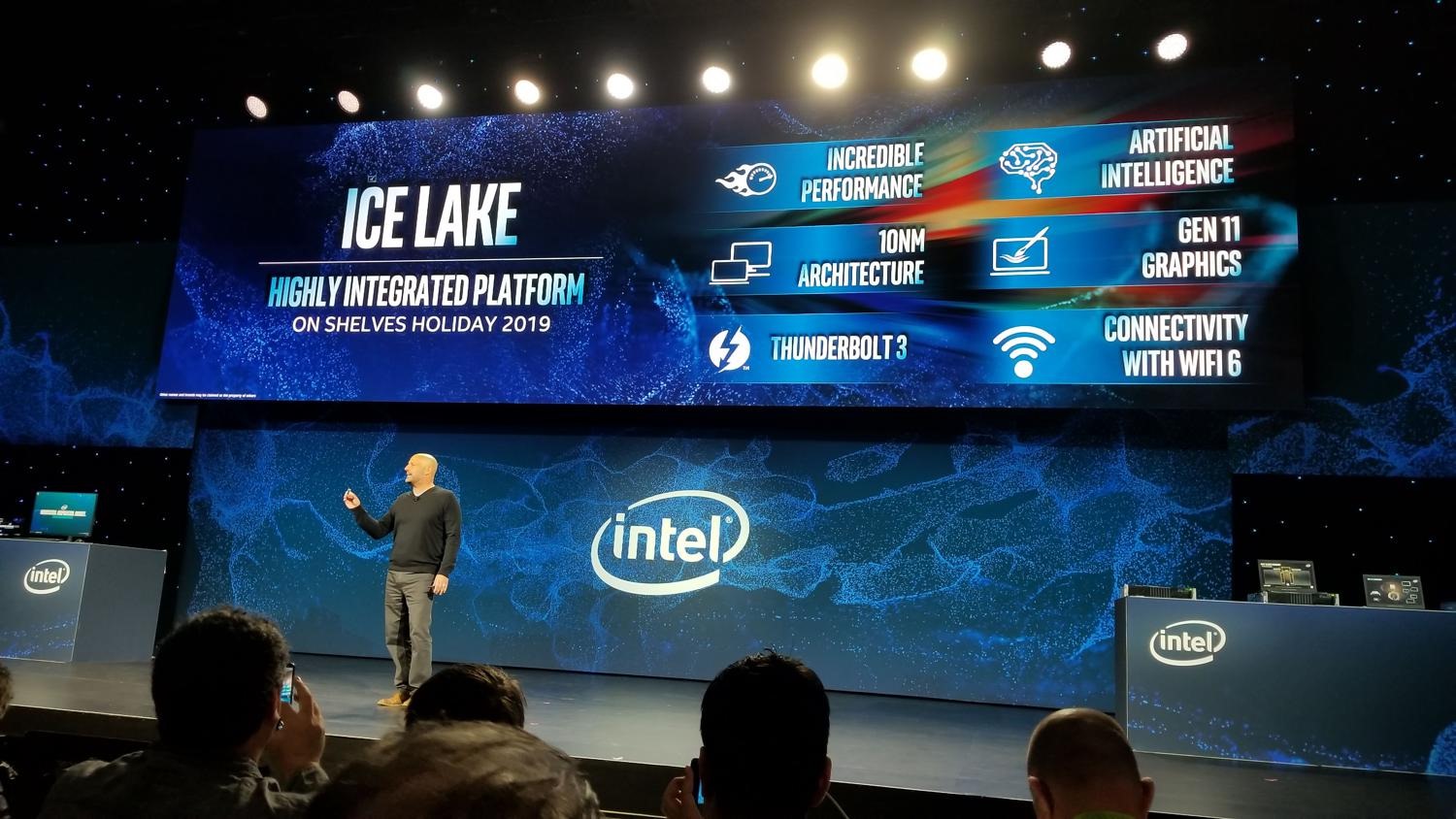
Ice Lake is the direct successor of Whiskey Lake processors for mobile devices. The main features of these processors are low power consumption, low TDP values and a small number of cores by modern standards.
')
The exact lineup was not presented, but according to Intel, all Ice Lake processors will have heat levels of 9, 15 or 28 W, an updated graphics core for this CPU family, as well as a dedicated dedicated logic block Gaussian Neural Accelerator and support for vector integer instructions DL Boost (Deep Learning Boost) for machine learning.
All new processors of the Ice Lake family are conditionally divided into Ice Lake-U and Ice Lake-Y. Ice Lake-U - "senior" model range of mobile processors with heat dissipation up to 15 W, Ice Lake-Y -
up to 9 watts. All processors will have a standard for mobile development type prefix 10xxxxU. The maximum number of cores for new processors is four (8 threads), they will be equipped with Ice Lake-U models. The claimed Intel maximum frequency in Turbo mode is, at first glance, quite impressive for such “babies” 4.1 GHz per core.
But the question is that we have already seen such frequencies: the same i7-8665U produced 4.8 GHz clockwise in single-threaded mode for CPU0, and the i7-8565U definitely showed 4.1 GHz on all four of its cores Turbo.
But the new processors still have significant differences from their predecessors Whiskey Lake. Their main feature is the new controller, which will support faster memory with new processors - up to DDR4-3200 with a channel up to 60 GB / s. According to the specifications on the official website of Intel, the company's engineers managed to achieve almost twice the channel and increase the supported frequency by a third: the i7-8665U only held DDR4-2400 / LPDDR3-2133 and had a channel of 37.5 GB / s.
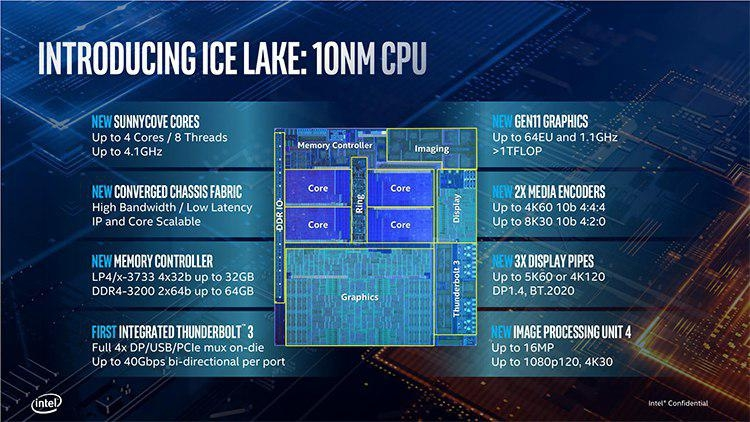
Of the interesting innovations, we have already mentioned the new logical block and support for vector integer instructions. The attentive reader asked himself the question: “Why?” And was right about something. It is not known how the innovations were positioned by the engineers during their work and whether these changes will find development in the “full-fledged” desktop processors from Intel in the future, but now these “gadgets” are needed to more effectively solve such tasks as speech recognition, simultaneous translation and semantic search . In this section, the mentioned innovations look more or less interesting, especially when it comes to processors for laptops and other mobile devices.
Intel also tried to please people who for some reason try to play on laptops. According to the presentation data, the new graphics core of Ice Lake processors called Intel Iris Plus is almost twice as productive as the current Intel HD Graphics 630, which is equipped with current Intel processors.
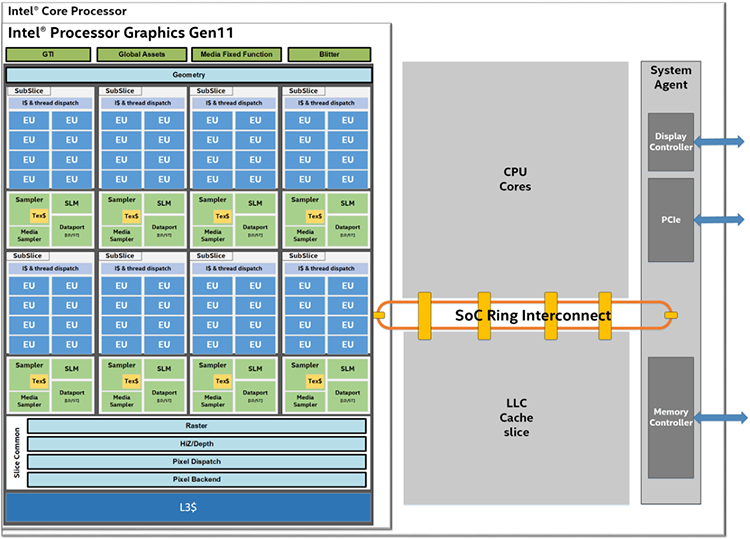
The presentation even led FPS tests in CS: GO. True, this game in terms of FPS growth is very demanding not on the graphics core, but on the performance of the processor itself, so that what Intel marketers have tried to prove is unclear. And the results were very mediocre: at 1080p in a smoke grenade, the FPS sagged to 60, and the overall stable value was at 90 frames per second.

By the way, for a comfortable gaming experience, such shooters require at least 120-200 (and preferably 300) frames per second when buffering is disabled (the latter causes a noticeable input lag and creates a kissel effect when operated). On the other hand, Intel does not compare its graphics core with full-fledged video frames, but simply provides graphs, according to which the new development is much more powerful than its predecessors in terms of FPS at 1080p resolution.
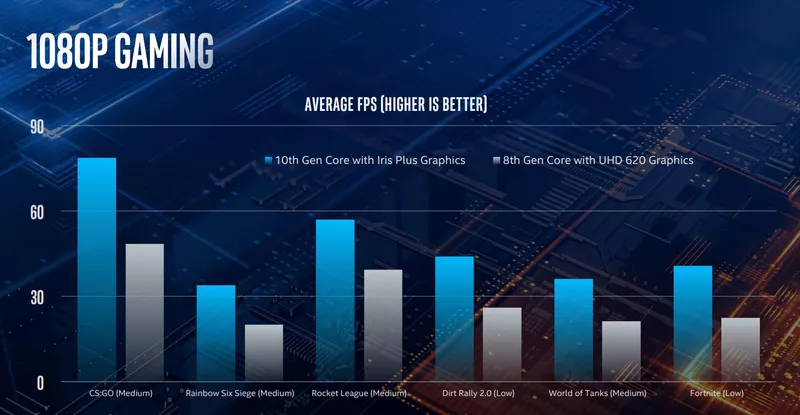
But in addition to 90 FPS in CS: GO, the new graphics core provides adequate support for screens and content playback in ultra-high resolution, as well as the ability to work with high frame rate displays. Intel claims that the new graphics core will cope with 120 Hz displays and 4K quality without any problems. Also, the new kernel supports HDR10 mode.
But what really matters for mobile devices is wireless. The Intel Lake Wi-Fi 6 Wireless Adapter (Gig +) is integrated into the Ice Lake platform. The company's proposed Wi-Fi implementation provides data rates of up to 1.7 Gbps. The integrated Thunderbolt 3 controller is designed to support up to four ports that are on opposite sides of the notebook. In addition, the new processors have an integrated Thunderbolt 3 interface with support for up to four ports of this type.

The first models of laptops with Ice Lake processors on board should appear in the fall as part of the Project Athena initiative - a project aimed at creating thin and light notebooks with high performance and equipped with the latest technological innovations. In other devices, Ice Lake processors should appear by the end of this year.
With desktop and notebook Xeon, which presented "on the sly" everything is much easier and calmer. Processor specifications tell us that they will be manufactured using the current Sky Lake technology and no architectural innovations that we see in Ice Lake mobiles will touch these processors:
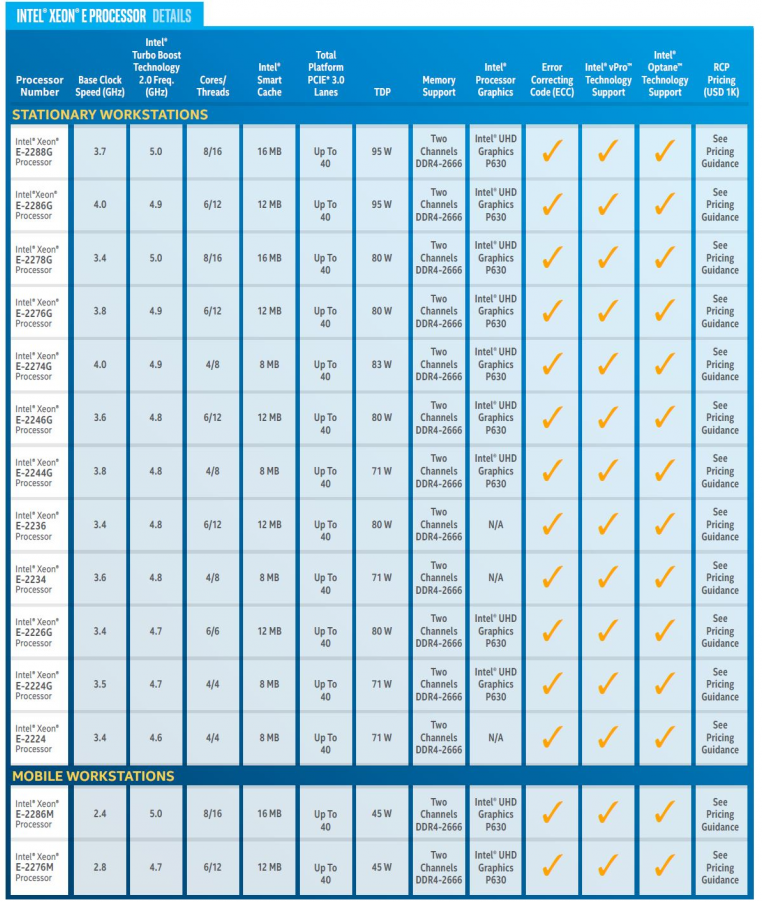
The cost of the new Xeon is not yet known, Intel will report this information later.

Ice Lake is the direct successor of Whiskey Lake processors for mobile devices. The main features of these processors are low power consumption, low TDP values and a small number of cores by modern standards.
')
The exact lineup was not presented, but according to Intel, all Ice Lake processors will have heat levels of 9, 15 or 28 W, an updated graphics core for this CPU family, as well as a dedicated dedicated logic block Gaussian Neural Accelerator and support for vector integer instructions DL Boost (Deep Learning Boost) for machine learning.
All new processors of the Ice Lake family are conditionally divided into Ice Lake-U and Ice Lake-Y. Ice Lake-U - "senior" model range of mobile processors with heat dissipation up to 15 W, Ice Lake-Y -
up to 9 watts. All processors will have a standard for mobile development type prefix 10xxxxU. The maximum number of cores for new processors is four (8 threads), they will be equipped with Ice Lake-U models. The claimed Intel maximum frequency in Turbo mode is, at first glance, quite impressive for such “babies” 4.1 GHz per core.
But the question is that we have already seen such frequencies: the same i7-8665U produced 4.8 GHz clockwise in single-threaded mode for CPU0, and the i7-8565U definitely showed 4.1 GHz on all four of its cores Turbo.
But the new processors still have significant differences from their predecessors Whiskey Lake. Their main feature is the new controller, which will support faster memory with new processors - up to DDR4-3200 with a channel up to 60 GB / s. According to the specifications on the official website of Intel, the company's engineers managed to achieve almost twice the channel and increase the supported frequency by a third: the i7-8665U only held DDR4-2400 / LPDDR3-2133 and had a channel of 37.5 GB / s.

Of the interesting innovations, we have already mentioned the new logical block and support for vector integer instructions. The attentive reader asked himself the question: “Why?” And was right about something. It is not known how the innovations were positioned by the engineers during their work and whether these changes will find development in the “full-fledged” desktop processors from Intel in the future, but now these “gadgets” are needed to more effectively solve such tasks as speech recognition, simultaneous translation and semantic search . In this section, the mentioned innovations look more or less interesting, especially when it comes to processors for laptops and other mobile devices.
Intel also tried to please people who for some reason try to play on laptops. According to the presentation data, the new graphics core of Ice Lake processors called Intel Iris Plus is almost twice as productive as the current Intel HD Graphics 630, which is equipped with current Intel processors.

The presentation even led FPS tests in CS: GO. True, this game in terms of FPS growth is very demanding not on the graphics core, but on the performance of the processor itself, so that what Intel marketers have tried to prove is unclear. And the results were very mediocre: at 1080p in a smoke grenade, the FPS sagged to 60, and the overall stable value was at 90 frames per second.

By the way, for a comfortable gaming experience, such shooters require at least 120-200 (and preferably 300) frames per second when buffering is disabled (the latter causes a noticeable input lag and creates a kissel effect when operated). On the other hand, Intel does not compare its graphics core with full-fledged video frames, but simply provides graphs, according to which the new development is much more powerful than its predecessors in terms of FPS at 1080p resolution.

But in addition to 90 FPS in CS: GO, the new graphics core provides adequate support for screens and content playback in ultra-high resolution, as well as the ability to work with high frame rate displays. Intel claims that the new graphics core will cope with 120 Hz displays and 4K quality without any problems. Also, the new kernel supports HDR10 mode.
But what really matters for mobile devices is wireless. The Intel Lake Wi-Fi 6 Wireless Adapter (Gig +) is integrated into the Ice Lake platform. The company's proposed Wi-Fi implementation provides data rates of up to 1.7 Gbps. The integrated Thunderbolt 3 controller is designed to support up to four ports that are on opposite sides of the notebook. In addition, the new processors have an integrated Thunderbolt 3 interface with support for up to four ports of this type.

The first models of laptops with Ice Lake processors on board should appear in the fall as part of the Project Athena initiative - a project aimed at creating thin and light notebooks with high performance and equipped with the latest technological innovations. In other devices, Ice Lake processors should appear by the end of this year.
With desktop and notebook Xeon, which presented "on the sly" everything is much easier and calmer. Processor specifications tell us that they will be manufactured using the current Sky Lake technology and no architectural innovations that we see in Ice Lake mobiles will touch these processors:

The cost of the new Xeon is not yet known, Intel will report this information later.
Source: https://habr.com/ru/post/453990/
All Articles